Hilton Head Landscapes Things To Know Before You Get This
Hilton Head Landscapes Things To Know Before You Get This
Blog Article
The 15-Second Trick For Hilton Head Landscapes
Table of ContentsHilton Head Landscapes Can Be Fun For AnyoneHilton Head Landscapes Fundamentals ExplainedThe 3-Minute Rule for Hilton Head LandscapesFascination About Hilton Head LandscapesWhat Does Hilton Head Landscapes Mean?All about Hilton Head LandscapesThe 7-Minute Rule for Hilton Head LandscapesThe Main Principles Of Hilton Head Landscapes
Kind compatibility is likewise a major element of unity in designone or more noticeably various types benefit comparison and focus, yet usually all various other types ought to have some similarities for a merged look. Texture describes exactly how coarse or fine the surface area of the plant or hardscape material feels and/or looks.
Instances of plants with coarse appearance include philodendrons, agaves, bromeliads, hollies, hands, and hydrangeas. Characteristics that create fine structure consist of small foliage; thin, strappy leaves (lawns) or tall, thin stems; little, dense branches and tiny branches; long stems (vines); and little, fragile blossoms.
The 10-Second Trick For Hilton Head Landscapes
A lot of plants are average structure, in that they can not be explained as having either rugged or fine texture. Medium-textured plants act as a history to web link and merge the rugged- and fine-textured plants.

To make a space feel smaller, place the coarse appearances along the external border and the great appearances closest to the visitor. The information of the coarse appearance makes the plants show up closer and makes the room really feel smaller sized. The perceived appearance of plants can also change with the distance from the plant.
How Hilton Head Landscapes can Save You Time, Stress, and Money.
Strong colors raise the contrast and make the texture show up coarser, while muted shades can flatten appearance. Hardscape with a rugged texturesuch as very harsh rocks and bold, huge timberstends to make all plant product show up extra average distinctive. Developers commonly develop an appearance study (Figure 8) theoretically to aid make a decision the setup of plant materials.
Color in plant material and hardscape includes passion and variety to the landscape. Shade is the most conspicuous element in the landscape and is normally the emphasis of most house owners; nonetheless, it is also the most momentary element, normally lasting only a couple of weeks a year for specific plants.
Hilton Head Landscapes - Truths
An easy description of the color wheel includes the three primaries of red, blue, and yellow; the 3 second shades (a mix of two primaries) of eco-friendly, orange, and violet; and 6 tertiary colors (a mix of one nearby primary and secondary color), such as red-orange. Shade concept explains the relationship of shades per various other and exactly how they must be made use of in a make-up.

Similar (sometimes called harmonious) color pattern are any three to 5 shades that are adjacent on the shade wheel, such as red, red-orange, orange, yellow-orange, and yellow, or blue, blue-violet, and violet (Landscapers near me). The shades relate to each other since they normally consist of 2 primary colors mixed to form a secondary and 2 tertiary shades, which means they share usual residential or commercial properties
Complementary shades are typically discovered naturally in blossoms; a typical pair is yellow and violet. Shade is located in the blossoms, foliage, bark, and fruit of plants.
Hilton Head Landscapes for Dummies
Eco-friendly vegetation in all its various shades is the leading color by amount, yet various other colors record attention quicker due to their high contrast to the color eco-friendly. Color is also found in structures, rocks, pavers, wood, and furnishings. A lot of colors in all-natural materials, such as stone and wood, are commonly low-key and often tend to be variations of brown, tan, and light yellow.
Colors have residential properties that can influence feelings, spatial understanding, light high quality, balance, and emphasis. Awesome colors often tend to be calming and ought to be used in locations for relaxation and serenity.
The Only Guide for Hilton Head Landscapes
The "temperature" of shades can likewise affect the assumption of distance. Awesome colors tend to decline and are perceived as being farther away, making a room feel bigger. Warm shades have a tendency to advance and are viewed like it as being closer, making a space really feel smaller. Shade can also be made use of to capture focus and direct sights.
For instance, intense yellow, which has the highest possible intensity, likewise has a high comparison with all other shades (usually referred to as a "pop" of color) and ought to be conserved. A tiny amount of intense color has as much aesthetic weight as a huge amount of a more suppressed or weak shade.
Similar (sometimes called harmonious) color design are any type of three to 5 shades that are surrounding on the shade wheel, such as red, red-orange, orange, yellow-orange, and yellow, or blue, blue-violet, and violet. The shades are related to each other since they commonly include two primaries mixed to develop an additional and two tertiary colors, which indicates they share typical homes.
Hilton Head Landscapes Fundamentals Explained
Complementary shades are commonly found normally in flowers; a common set is yellow and violet. Color is located in the flowers, foliage, bark, and fruit of plants.
Environment-friendly foliage in all its various tones is the dominant shade by quantity, yet other shades capture focus quicker due to their high comparison to the color environment-friendly - hilton head landscapers - https://hilton-head-landscapes.webflow.io. Shade is likewise found in structures, rocks, pavers, wood, and furnishings. Many colors in all-natural materials, such as rock and timber, are commonly low-key and tend to be variants of brownish, tan, and pale yellow
4 Easy Facts About Hilton Head Landscapes Described
Colors have homes that can impact emotions, spatial understanding, light quality, balance, and emphasis. Cool shades often tend to be relaxing and need to be made use of in locations for relaxation and peacefulness.
Great shades tend to recede and are regarded as being further away, making a space really feel larger. Shade can likewise be used to record interest and straight sights - https://worldcosplay.net/member/1787568.
As an example, bright yellow, which has the highest possible intensity, likewise has a high contrast with all various other shades (usually explained as a "pop" of shade) and must be conserved. A percentage of intense color has as much aesthetic weight as a large quantity of a more restrained or weaker shade.
Report this page